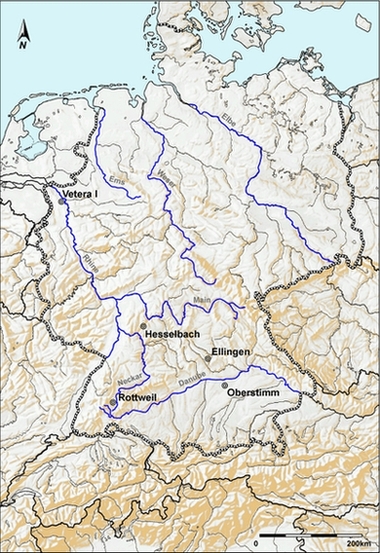Engendering Roman Military Spaces
Penelope M. Allison, 2008. (updated 2012) https://doi.org/10.5284/1017082. How to cite using this DOI
Data copyright © Dr Penelope M. Allison unless otherwise stated
This work is licensed under the ADS Terms of Use and Access.
Primary contact
Dr
Penelope M.
Allison
Schools of Archaeology and Ancient History
University of Leicester
University Road
Leicester
Leicestershire
LE1 7RH
UK
Tel: 0116 2522735
Resource identifiers
- ADS Collection: 809
- DOI:https://doi.org/10.5284/1017082
- How to cite using this DOI
Engendering Roman Military Spaces
Dr. Penelope M Allison, 2008
Overview

This archive comprises the dataset that was developed from the published excavation reports of the five forts used in the Engendering Roman Military Spaces project and the interactive maps that were generated from this dataset to analyse the distribution of activities within these forts, and to identify the people who carried out those activities.
The project comprises data from the printed publications of five early imperial forts in the German provinces - Vetera I1 , Rottweil2 , Oberstimm3 , Hesselbach4 and Ellingen5 . Vetera I was a double legionary fortress in the lower Rhine region, founded by Augustus c. 9 BC and abandoned during revolutionary upheavals c. 70 AD. The forts studied at Rottweil on the Neckar near the upper Rhine consist of Fort I, a legionary fortress dated to c. 75 AD which followed three earlier Vespasianic auxiliary forts, and Fort II, a smaller double cohort fort which replaced Fort I in 85 AD. Fort II was abandoned c. 110-120 AD. The fort at Oberstimm, in the upper Danube, was occupied between 40 AD and 120 AD. That at Hesselbach, between the Neckar and Main and dating to the 2nd century, is included in this study as a control. The auxiliary fort at Ellingen, also in the upper Danube region, was occupied from c. 120 AD until probably the end of the 2nd century. Thus, these forts form a sample of types of military forts in the Roman provinces during the early empire.
Spreadsheets
The dataset for this archive consists of one spreadsheet developed from the published artefact catalogue of each of the five sites studied, which have been translated from German into English6. The spreadsheets include fields that comprise the catalogue numbers and description of the artefacts and any dating, provenance, and reference information, as published in the excavation reports. Further dating information has been added through analyses of the site phasing and the chronologies of artefact types. Only those artefacts in the original catalogues that can be assigned activity and gender categories, as relevant to this study, are included in these spreadsheets. These activity and gender categories have been generated as part of the analyses of this project and are assigned to the relevant fields in the spreadsheets. The processes for assigning these categories to specific artefacts is discussed in the forthcoming publication, Frontier Communities in the Early Roman Empire: artefactual evidence for women and children inside German military bases [working title]. These categories include activities such as metalworking and cloth production as well as items associated with dress. They also include 'possible' activities, or a range of activities, when the precise function of an artefact is unclear. Likewise, the gender categories include a range of 'genders' from items associated with more 'definitely' male or female activities or dress and those 'possibly' associated with female and male activities or dress. In addition, they also include items associated with children, including infant skeletal remains. Two other spreadsheets, included in this archive, give the range of these categories and the abbreviations used in the shape files and interactive maps.
Shapefiles
Numerous shape files have been generated from queries on the activity and gender fields in these spreadsheets and these are included in this archive. Where possible shape files have also been generated by running queries on the building and occupation phases of the forts, to identify any association of these items and activities with specific fort phases. The codes used for the labels of these shape files indicate the site (e.g. Ellingen = E) and the activity.
Shape files of overall forts and of the individual features and buildings within each fort are also included. In some cases separate shape files have been also produced for the different building phases of each feature.
Related Publications
Related publications from Internet Archaeology:
- Extracting the social relevance of artefact distribution within Roman military forts
- Procedures for Measuring Women's influence: data translation and manipulaton and related problems
- Measuring Women's Influence on Roman Military Life: using GIS on published excavation reports from the German frontier
See also:
- P. M. Allison. Mapping for Gender: Interpreting artefact distribution in Roman military forts in Germany, Archaeological Dialogues 13.1 (2006): 1-48 (discussion paper, 5 commentary papers and response, supplementary figures: http://www.journals.cup.org/abstract_S1380203806211851).P. M. Allison 2007.
- Artefact distribution within the auxiliary fort at Ellingen: evidence for building use and for the presence of women and children, Bericht den R�misch-Germanischen Kommission 87 (2006): 387-452.
1Hanel, N. (1995), Vetera I: Die Funde aus den r�mischen Lagern auf dem F�rstenberg bei Xanten,, Cologne and Bonn.
2Franke, R. (2003), Arae Flaviae V: Die Kastell I und II von Arae Flaviae/Rottweil und die r�mische Okkupation des oberen Neckargebietes. Forschungen und Berichte zur Vor- und Fr�hgeschichte in Baden-W�rttemberg, Landesdenkmalamt Baden-W�rttemberg, Band 93. Stuttgart.
3Sch�nberger, H. (1978), Kastell Oberstimm, die Grabungen von 1968 bis 1971. R�misch-Germanisch Kommission. Limesforschungen Band 18. Berlin.
4Baatz, D. (1973), Kastell Hesselbach und andere Forschungen am Odenwaldlimes. R�misch-Germanisch Commission. Limesforschungen Band 12. Berlin.
5Zanier, W. (1992), Das R�mische Kastell Ellingen. R�misch-Germanisch Commission, Limesforschungen Band 23. Mainz am Rhein.
6 This translation, especially ofthe artefact descriptions, is sometimes rather cursory and literal. For more precise identification of particular characteristics of these artefacts the original text in the excavation reports needs to be consulted.





